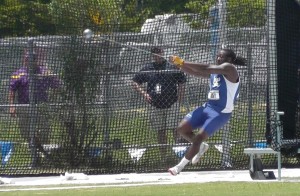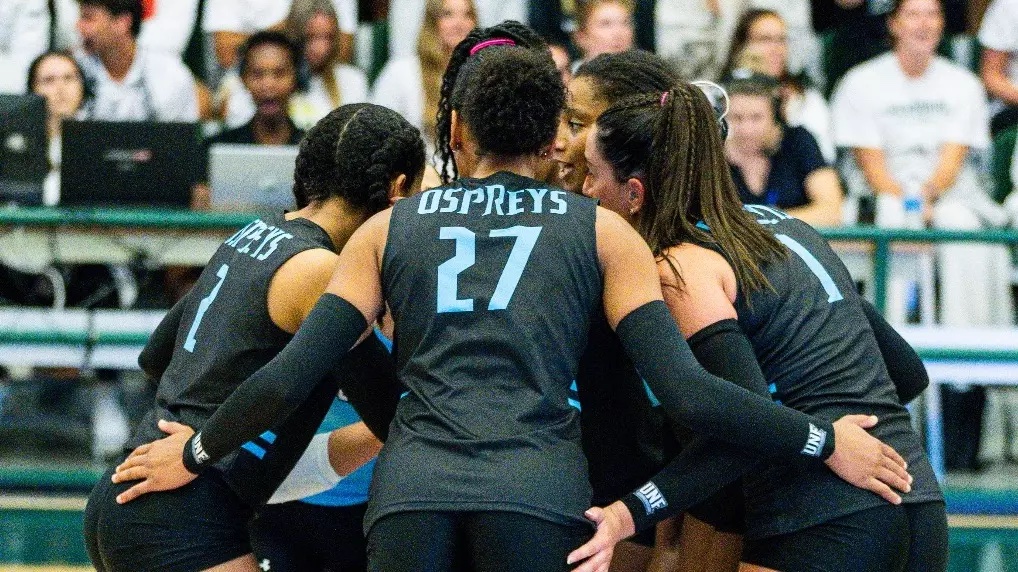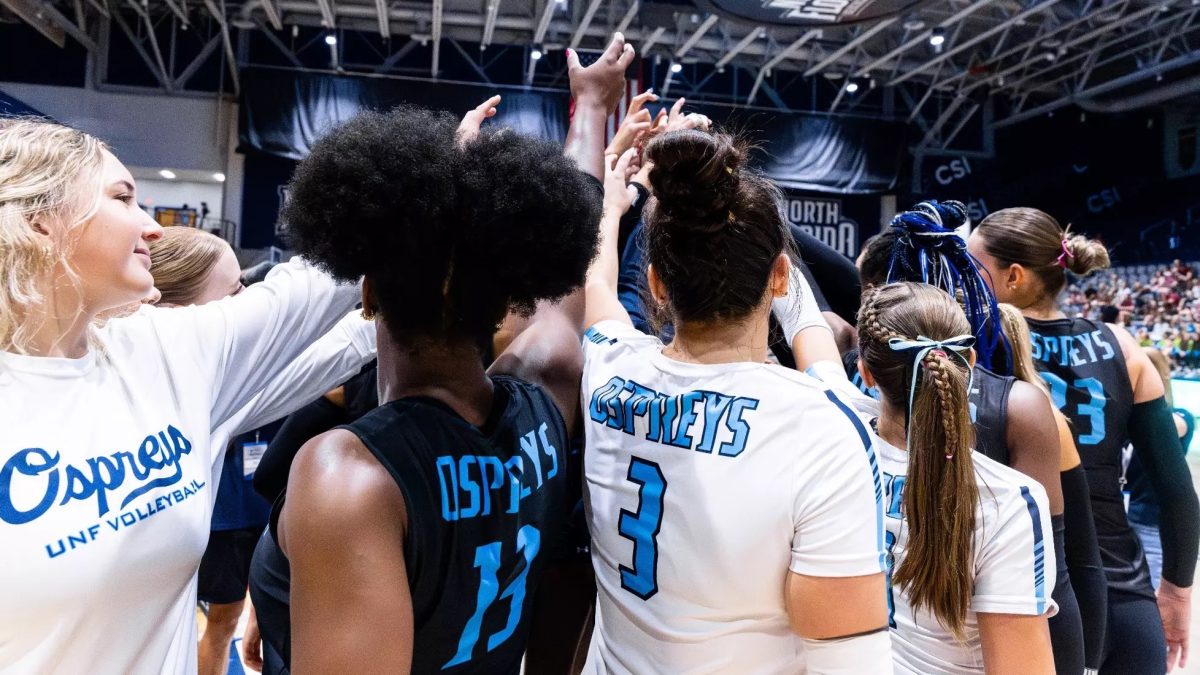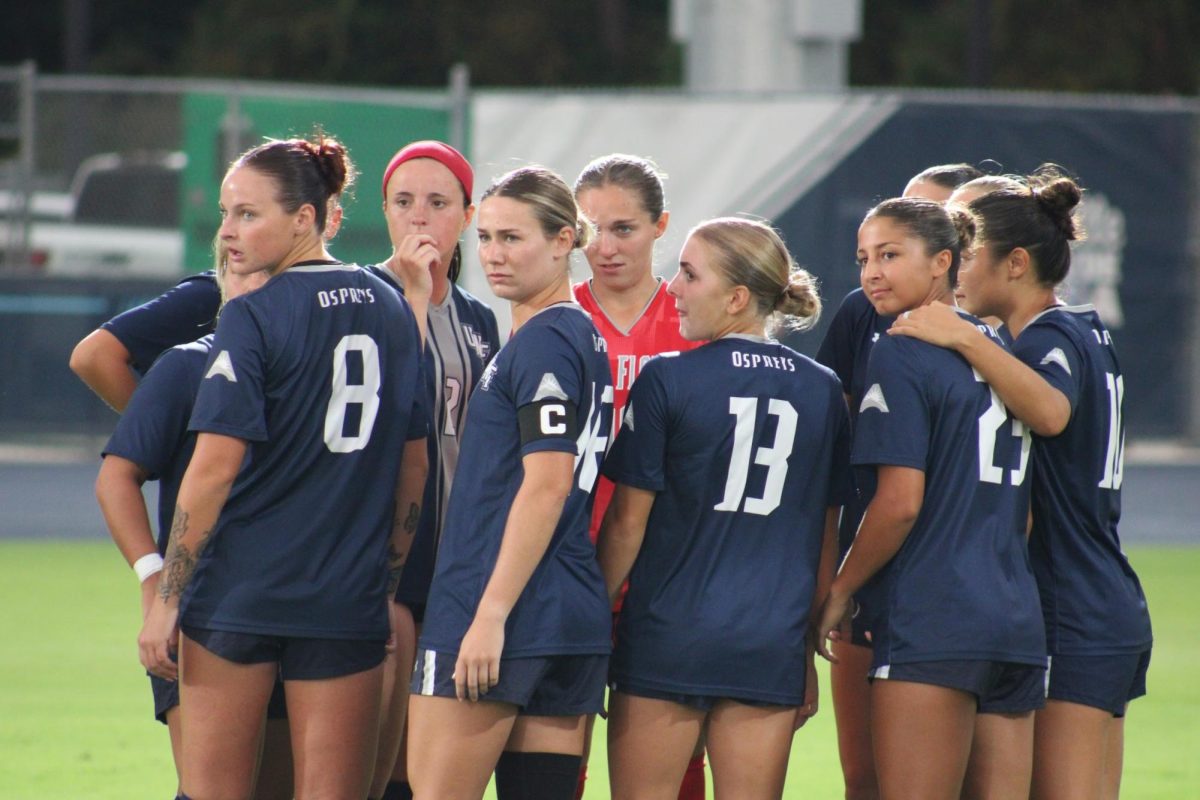
Pole vaulters run at full speed, stab a 15-foot pole into the ground and thrust their entire body weight 13 feet into the air over another pole.
Because of this, athletes, officials and track coaches involved with the 2012 NCAA East Regional Championships in track and field agree that pole vaulting is the most dangerous game among the field events.
Pole vaulting can be very dangerous, said Christina King, a UNF pole vaulter who competed in the regional championships held May 24-26 at UNF’s Hodges Stadium. It takes good coaching, body awareness and confidence, King said.
King said she has broken her nose from the crossbar and sprained her ankle twice.
King sprained her right ankle last week pole vaulting in preparation for the 2012 NCAA Championships.
“The sport is inherently dangerous because you run at full speed, almost 100-meter sprint with a 15- to 17-foot fiber glass pole in your hand, then you’re bending it, trying to get upside down to clear a bar in the air,” said Chris Hord, a UNF assistant pole vault coach.
Hord said a lot could go wrong when pole vaulting, such as coming up short, the pole breaking or hands slipping.
“You’re falling from the highest when you pole vault, so it’s easier to get hurt, unlike the other field events where you don’t go anywhere,” said Caleigh Boyington, a UNF pole vaulter.
Hord said he has known more deaths in pole vault than any other sport. There were three deaths alone in 2003, he said, but teaching the proper from and technique can mitigate the issues.
Still pole vaulting at the age of 60, Ken Taylor, a UNF track and field assistant coach, said pole vaulting would have to be the most dangerous sport because when athletes pole vault, they may miss the pit.
David Shepherd, a UNF pole vaulter who also competed in the 2012 NCAA East Regional, missed the mat in the Florida Relay and landed on a girl, he said.
Shepherd said he used to wear a helmet while pole vaulting.
There are more deaths in track and field caused by pole vaulting than any other sport, Taylor said.
“A lot of coaches don’t think about safety first,” he said. “We have never had an athlete seriously hurt at UNF because we teach the right technique.”
Since 1980, 20 athletes have died pole vaulting, while 38 have suffered skull fractures and 44 have sustained serious injuries, the Daily Pennsylvanian reports.
And while pole vaulting may be the most dangerous, the javelin throw and hammer have the potential for serious injuries, as well.
The javelin throw, which requires running at full speed and chucking an 8-foot spear into the air, is also very hazardous.
Rodney Smith, a 2012 NCAA East Regional Championships official said the javelin and hammer are most dangerous to spectators and require undivided attention.
Smith said he hasn’t seen anyone injured, yet, but he has seen a lot of athletes and spectators come close by not paying close attention to what they are doing.
In the hammer throw, the athlete is projecting a heavy metal ball attached to a chain in the air to see who can throw the farthest. The women’s ball is usually 8 pounds, and the men’s is 16 pounds. A large black net is encased around the athlete, which offers protection to officials and the crowd.
Paramedic D.J. West said there have been no injuries as of early afternoon May 26 for the 2012 NCAA East Regional Championships, but the most dangerous threat would likely be someone passing out from a heat stroke.








xwpis onoma | Sep 6, 2020 at 11:44 pm
Stupid article!
Dorkfish | Jul 7, 2020 at 11:36 pm
Who cares
Beth Barrs | Jul 5, 2020 at 8:23 am
Statistically speaking so many people died or were seriously hurt while doing this sport, no matter whether it’s bad coaching, equipment failure, or by accident…those dangers and factors make it that dangerous compared to other sports where people get hurt but not as many killed or not as many seriously hurt with the same factors of bad coaching, equipment failure, or by accident taking place in the other sports. That’s how statistics work.
Jennifer Calliston | Feb 16, 2020 at 8:15 pm
Cris wei, I completely agree. I do believe that they should not have published this article without the experience of an actual pole vaulter. Before I joined pole vault in 06, I was terrified, watching poles snap and stuff like that. It’s just the quality of the stick and the coaches, like you said. If I had went to this article before I started (it wasn’t published, but for the example), I don’t think I would start. It’s scaring people out of doing something so fun. Do more research, author.
Cris wei | Feb 4, 2020 at 3:53 am
This is the most irresponsible article I’ve ever read. Clearly the author has never pole vaulted themselves, nor did they actually do even a cursory amount of research to familiarize them self with the event. Pole vault isn’t dangerous. Inadequate equipment, and undereducated coaches are dangerous. Pole vault is just as safe as any gymnastics practice or competition. Author should be ashamed.
Michael C. Kelly | Dec 26, 2019 at 2:03 pm
Similarly. Mr. Compton , I pole vaulted from 1959 to 1963 – HS Then, from 1963 to 1968 – College.
Always have used an Aluminum or Swedish Solingen Steel pole. Never used a bending slingshot pole. The Solingen Pole, I used in Senior year high school, just prior to State Conference Meet, had been dented, after crossbeam stand fell on it. Staff member who welded it said : “No sweat! It’s good to go!” His ,so called: “Good to go, didn’t quite cut it”; Especially, during the following week’s Major Conference state meet.
During my 3rd vault attempt at only 11’6”, everything was tracking. Then , feet skyward, body ,semi upside down, I was up about 10 feet and —pulling up into a semi handstand , when : “ Bong” …..The pole snapped right in half . My pendulum momentum swung me into a complete backflip 360 degree rotation. Thankfully, I landed flat out -on my back -on the only semi – soft sand. I was fortunate not have landed on my neck or head. Since, I’d broken the magic barrier, I wasn’t allowed a fourth shot at it. Disappointed, I argued with ref. for a fourth try , but, no luck luck. Or ….maybe good luck.
Agree with your rundown on the dangers of this sport. But even at 74, if I hadn’t had a recent back surgery, I’d try it again. So much —for common sense. Thanks for your insightful article.
Be well.
Bob Compton | Mar 11, 2019 at 9:16 pm
As a former college pole vaulter in 1956 to 1960 I would like to raise another concern. I would like to address the potential problem of subtle brain injury from repeated falling from great heights followed by rapid deceleration and shaking of the brain. In my day we had rigid poles and only saw dust in which to land. We probably fell from a higher distance even though the bar was lower because of the raised foam landing area. Also there was great shock from planting the pole due to the rigid pole, again the brain responds to this sudden stopping. I was never injured from landing outside the area, etc, but I was once knocked out when falling on my head after breaking a pole. Despite some serious injuries I have never heard of anyone dying from pole vaulting in those days. I have often worried about injury to the brain similar to that occuring in football.